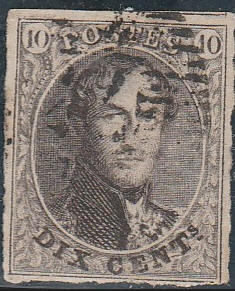History of Postage Stamps in Belgium
The history of postage stamps in Belgium is rich and fascinating, beginning in the 19th century and developing into an extensive system that reflects the country’s cultural, political and social changes. Here is a chronological overview of the most important moments and developments in the history of Belgian stamps:
Early period (1849-1865)

- 1849: Belgium introduces its first postage stamp on July 1, 1849. Known as the “Epaulettes”, this stamp shows a portrait of King Leopold I, the first king of Belgium. The stamp had a face value of 10 centimes and was brown in color.
- 1849: At the same time a second stamp was released with a value of 20 centimes, in blue color. Both stamps were printed on handmade paper without watermark and had no perforation.
Expansion and Innovation (1866-1909)
- 1865: A new series of stamps is introduced with the portrait of Leopold I in profile. These stamps were serrated, which was a novelty compared to the earlier issues.
- 1866: Postage stamps with a portrait of King Leopold II are issued. These stamps had different values and colors and introduced new security features such as watermarks.
- 1893: Belgium introduces its first stamp for special use: a service stamp for official postal items.
World War I and Interbellum (1914-1939)
- 1914-1918: During World War I, German troops occupy Belgium, and special occupation stamps are issued.
- 1919: After the war, Belgium returns to issuing regular stamps. Commemorative stamps are issued in honor of the end of the war and the reconstruction of the country.
- 1928: Belgium introduces airmail stamps to support its growing airmail service.
Second World War and Occupation (1940-1945)
- 1940-1944: During the German occupation of Belgium during the Second World War, occupation stamps are issued again.
- 1944: After the liberation, stamps with the portrait of King Leopold III are reissued.
Post-War Period and Modernization (1946-present)
- 1946-1950: Belgium begins issuing modern commemorative postage stamps celebrating important historical events, cultural icons and technological advances.
- 1952: Special commemorative postage stamps are issued on the occasion of the centenary of the Belgian postage stamp.
- 1960-present: Belgium continues to issue a wide range of thematic stamps, including stamps celebrating artists, scientists, sporting events, and national holidays. Stamps are increasingly printed with advanced techniques such as photogravure and digital printing.
Important Features of Belgian Postage Stamps
- Portraits of Monarchs: Belgian postage stamps often feature portraits of the reigning monarchs, such as Leopold I, Leopold II, Albert I, Leopold III, Baldwin, and the current King Philippe.
- Commemorative stamps: There are numerous commemorative stamps that honor important events and people from Belgian history.
- Thematic Diversity: Modern Belgian stamps cover a wide range of themes, including art, culture, science, nature, and sports
-
- Congo Free State (1885–1908) / Belgian Congo (1908–1960)
- The Congo Free State was initially the personal property of King Leopold II, who ruled it independently. The administration under Leopold was marked by brutal exploitation and atrocities, leading to international outcry. In 1908, following significant pressure, Belgium took over control from Leopold, renaming it the Belgian Congo. It remained a Belgian colony until it gained independence in 1960, becoming the Democratic Republic of Congo.
- Ruanda-Urundi (1916–1962)
- During World War I, Belgium occupied these two regions (now Rwanda and Burundi), which were previously part of German East Africa. After the war, the League of Nations granted Belgium a mandate to govern them, and later the United Nations continued this mandate as a trust territory. Ruanda-Urundi remained under Belgian control until it gained independence in 1962, separating into the independent nations of Rwanda and Burundi.Belgium had several colonies during its imperial period, primarily in Central Africa. Here are the main territories that were colonized by Belgium:
- Congo Free State (1885–1908) / Belgian Congo (1908–1960)
